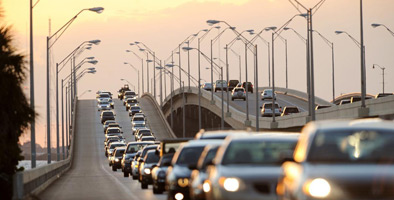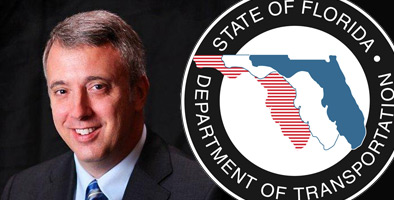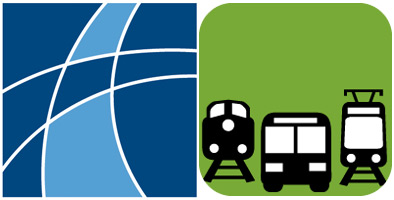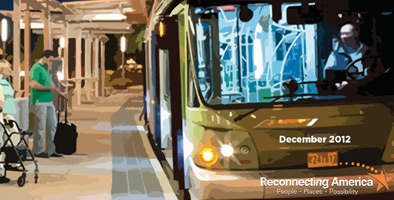|
Transit eNews of the Hillsborough Metropolitan Planning Organization and its Transportation Disadvantaged Coordinating Board (TDCB)
|
|
|
|
|
|
|
Grassroots group seeks transportation choices

A new grassroots advocacy organization wants to hear what YOU think Tampa Bay needs in terms of transportation choices. Called Connect Tampa Bay, it's existed only since late last year yet has already attracted more than 1,800 members.
"We want to get more people engaged in creating options," said Kevin Thurman, Executive Director of Connect Tampa Bay. Over the next several months, the group plans on holding 50 "house meetings" to invite people around Tampa Bay to discuss what's needed and how they would fund it. Connect Tampa Bay will also hold seven "open mic" nights, the first two of which will be forums co-hosted with the Pinellas Realtors and Greater Tampa Chamber of Commerce.
People often regard transportation as just a personal problem rather than a community issue, said Thurman. "It starts with people telling their stories, and they soon realize they share certain transportation issues," he said. Once they agree there's a common transportation problem, they then begin to zero in on solutions and steps the community can take to make them a reality.
Raised in Southern California and having moved all around the U.S., Thurman said he's seen how decisions made by some cities have made it literally impossible to get around by anything other than a car.
Anyone is welcome to join Connect Tampa Bay but the group is targeting specific age groups with a major stake in transportation, such as those under 40 and seniors. There is no cost to join.
"We're a 21st century organization," claims Thurman, because people only need to sign up and they can participate with varying degrees of involvement. Furthermore, Connect Tampa Bay will not advocate a position on any specific solution or funding option until members vote on it.
For more information, visit ConnectTB.com.
|
|
Tampa bus driver returns $2,200

William Goodrich remembers sitting and organizing his wallet as he rode the No. 33 bus down Fletcher Avenue. After all, it was stuffed with cash - $2,200 from checks he had converted in hopes of using it toward a down payment on a house he is buying in Seminole Heights.
When he got home, he noticed the wallet was missing. He retraced his steps and called the headquarters for HART, Hillsborough Area Regional Transit. No one had turned it in, he was told. Call back tomorrow.
Goodrich didn't sleep much that night.
Wednesday, he called HART and got voicemail. He left a message. He breathed a sigh of relief at the callback: Someone had indeed found the wallet and turned it in. All that money, too. "My prayers had been answered," said Goodrich, 58, of Tampa. "God is looking out for this fool one more time. I sure need all the looking out."
Goodrich said acquaintances told him to move on, that whoever found the wallet was certain to take the money and run. "I was a little bit skeptical," Goodrich said. "Being the Christian that I am, I was praying that the right person would find it. And they did."
Bus driver Wilfredo De La Paz said he was checking the bus early in his shift, after reaching the end of the line on Route 33. The wallet was right on top of a seat in the middle of the bus, he said. "Luckily, I found it first because some people wouldn't have turned that in," De La Paz said. "There was a lot of money in there." He looked in the wallet and saw an identification card. He recognized Goodrich, a regular bus rider. He even remembered that Goodrich had done a good turn on the bus recently, stepping in to calm a heated argument between a man and a woman at a bus stop.
|
Steinman named FDOT Dist. 7 Secretary

Paul Steinman has been named District Seven Secretary for the Florida Department of Transportation. Steinman was the Chief Operations Officer for the Idaho Transportation Department since December 2010. He was state construction engineer for FDOT from March 2009 until November 2010. Steinman is a 1989 graduate of Michigan State University with a bachelor's degree in civil engineering. Most of his career has been in the state of Michigan. He is a licensed engineer in Florida, North Carolina, Michigan and Idaho, according to FDOT. Steinman starts on March 1. He replaces Don Skelton, who retired last year to head the local office of H.W. Lochner Inc. District Seven includes Citrus, Hernando Hillsborough, Pasco and Pinellas counties.
For more information visit FDOT District 7.
|
|
HART Tests "OneBusAway" App

The University of South Florida's Center for Urban Transportation Research (CUTR) in collaboration with Georgia Institute of Technology and Hillsborough Area Regional Transit (HART) announced a pilot program and research study launching a new smartphone app that tracks the location of HART buses. Called "OneBusAway", the app uses GPS technology to track buses in real-time, so riders will know if their bus will arrive on-time. The app was developed by researchers at the University of South Florida in coordination with researchers at Georgia Institute of Technology. HART project making the app available to the general public by late summer 2013. For more information contact Shannon Haney at haneys@gohart.org. |
|
USF St. Pete introduces Car Sharing

USF St. Petersburg has launched its first car-sharing program, an affordable transportation alternative that will be available for for students, faculty and the general public. The new program, announced today by St. Petersburg Mayor Bill Foster and USFSP Interim Regional Chancellor Bill Hogarth, will be operated by WeCar by Enterprise, which runs a similar program at USF Tampa. The program was initiated by the Center for Urban Transportation Research at USF Tampa in partnership with WeCar by Enterprise, the Florida Department of Transportation District Seven and USF St. Petersburg. The program is open to USF St. Petersburg students, faculty and staff immediately and to the general public in the coming weeks. The membership-based, automated car rental option offers an environmentally sustainable, efficient and cost-effective alternative around the clock. Two vehicles, a Nissan Cube and a Fiat 500, will be available for registered members at covered spots at the USFSP parking garage, 250 5th Ave. South. More cars can be added depending on demand. Mayor Foster praised the initiative as the latest example of the longstanding partnership between the city and its only public university. "As the first green city in Florida, St. Petersburg is committed to being a good steward of the environment," Foster said. "This program will enhance St. Petersburg's reputation as a livable city." Under the program, USFSP students who are registered members 18 or older can reserve a car online. They access the vehicle using a membership card and then return it to the same location. Fuel, basic physical damage and state-required liability protection are included in the standard rate plan, which begins at $8.50 an hour. Non-students must be at least 21. Car-sharing programs are especially popular with students because they provide a solution to car rental age restrictions as well as financial concerns associated with having a car on campus. A credit card is required to register. The program is designed for short trips, such as a day at the beach or shopping at the mall. Full-day rentals are also available. |
|
Access Pasco Transit

Pasco County Public Transportation (PCPT), in coordination with the Pasco County Metropolitan Planning Organization, kicked off a major update to the County's 10-year Transit Development Plan (TDP). Dubbed Access Pasco: A Plan for Transit, the update will serve as a guide for the future of public transportation in Pasco County from 2014-2023. It represents the transit agency's vision to promote transit growth and improvement in Pasco over the next decade.
Public participation is an important part of the process, and numerous activities have been planned to support Access Pasco, including a bus on-board survey, stakeholder interviews, focus group discussions, open house public workshops, and a transit summit.
Members of the public are encouraged to attend one of several open house public workshops to provide input on existing and future transit services. Staff and consultants will be available at these workshops to provide information, answer questions, and take comments.
Friday, April 12, 2013 - 11 am-2 pm
Hugh Embry Library
14215 North 4th Street, Dade City, Florida 33523
(PCPT Bus Routes 30 & 31)
Tuesday, April 23, 2013 - 11 am -2 pm
West Pasco Government Center Lobby
8731 Citizens Drive, New Port Richey, FL 34654
(PCPT Bus Routes 14 & 23)
For more information on Access Pasco, please contact PCPT at (727) 834-3322 or info@ridepcpt.com.
|
|
Midsized Cities on the Move

A Look at the Next Generation of Rapid Bus, Bus Rapid Transit, and Streetcar Projects in the United States Mid-size cities that are too small to be among the top tier, but too big to qualify as small towns. These cities can range in size from 50,000 to 250,000 in population. They are not merely smaller versions of large metropolises, nor are they just "bigger" small towns. Midsize cities are a stand-alone group, with their own unique set of amenities and challenges. Yet, like their larger and smaller counterparts, they too have invested in the development of transit systems to serve their communities. More than 250 transit systems serve midsize cities in the US, providing more than 1.5 billion trips each year. The backbone of the transit network in most midsize cities is bus service, which in some cases extends into the larger region. This bus service may be complemented by express or commuter service, paratransit for individuals with disabilities, and other special services. The success of these systems, and continuing challenges in addressing residents' mobility needs, has led local leaders in some midsize cities to take a new approach to transit. Across the country, midsize cities are investing in new rapid bus systems, bus rapid transit, streetcars, and other improvements to better connect suburbs with city centers, to move people between employment centers, and to improve overall connectivity among key destinations. These new transit investments promise to bring not only improved mobility for local residents, but can also be the catalyst for community revitalization, economic development, and improved connectivity between the transit system and surrounding community uses. This report explores that "next generation" of transit in midsize cities, with a focus on best practices in transit planning, funding strategies, and actual or projected outcomes. The goal is to provide elected leaders, planners, and other stakeholders at the local, regional, state, and federal levels with examples of innovative transit in midsize cities that they can draw upon to improve transportation options in their own communities. Transit Investments The backbone of transit service in midsize cities is buses. For many cities in this size range, developing an integrated network of bus routes that connect key destinations and residential areas is the primary focus of transit planners. Even among midsize cities, there are often major employment centers, medical facilities, or universities which are located outside the central business district, and transit can serve as a mechanism for better integrating these places into the fabric of city life. In some cities, local bus routes will connect with regional or express buses or commuter rail to create a seamless connection with other parts of the region. For example, in Orlando the transit agency is planning an extension of its bus rapid transit system that will connect residential neighborhoods with the city's central business district, and also connect to the new SunRail commuter line that will open in 2014. Among midsized sample cities, the most common choices for a major transit investment were rapid bus, bus rapid transit (BRT), or streetcar, which are described below. Light rail and heavy rail (subways) are typically more costly options that require minimum residential densities and higher concentrations of downtown workers than midsize cities usually have. Rapid Bus and Bus Rapid Transit Rapid bus and bus rapid transit (BRT) refer to bus service that has different characteristics with regard to speed, frequency, and passenger amenities than regular bus service. A growing number of US cities have implemented rapid bus systems. While numerous international examples of BRT exist, few BRT systems operate in the United States. As a result of this country's limited experience, such systems are not as familiar as conventional bus service nor has there been a universal standard for the way BRT systems are implemented in the US. Rapid bus and BRT systems typically include some or all of the following features in order to achieve improved service: - Dedicated running ways that allow buses to operate apart from the rest of the traffic. These can be lanes on a street or highway that are separated from other traffic with physical barriers,or simply painted to say "bus only".
- Priority for buses at intersections that allow a bus to switch a traffic light to green or provide a "queue jump" lane to allow the bus to bypass stopped traffic.
- Frequent service, typically 15-minute or better headway, makes the rapid bus or BRT system more convenient and attracts more riders.
- Vehicles with level boarding and other amenities such as Wi-Fi or more comfortable seating, serve both to attract more riders and to speed boarding.
- Off -board fare collection speeds boarding by allowing passengers to pay for their trip before boarding the bus.
- Greater distance between stops allows the rapid bus or BRT system to achieve greater speeds and reliability.
- More substantial stations than a typical bus stop, including seating, real time arrival information, shelter, and other amenities.
- Unique branding serves to distinguish the rapid bus or BRT system from regular bus service, making it easier for riders to identify and use.
Overview of Streetcars Streetcars refer to a type of public transportation that operates on rails and is usually powered by electricity either overhead or through an underground third rail. Streetcars operate in shared lanes in mixed traffic or dedicated lanes on streets and usually operate as a circulator, connecting destinations in and around downtowns with other major entertainment, business and activity centers. In some cities, streetcars may be referred to as trolleys or trams. Unlike light or heavy rail, streetcars are not designed to carry many people over long distances at high speeds. The average streetcar makes frequent stops, is approximately 2-3 miles in length, has an average speed of about 3-5 miles per hour, can adapt to the existing built environment, and has smaller sized vehicles. They differ from buses in that they run on fixed-guideways, which are permanent infrastructure investments, rather than on routes that can be changed.  Replica Streetcar Modern Streetcar View a comparison of major transit projects in sample cities. |
|
Op-Ed: US has only 5 true BRT systems, none meet "gold" standard

When new Bus Rapid Transit (BRT) lines are discussed, proponents often say they hope to make the routes gold standard, meaning so high-quality that they mimic many features of rail. That's a high bar; most BRT projects in the United States don't even qualify as true BRT, and so far not one has actually met the gold standard.
The Institute for Transportation & Development Policy publishes BRT standards that describe minimum characteristics necessary for a bus route to qualify as BRT. Those standards establish three levels of BRT quality: bronze, silver, and gold. They include features like off-bus fare collection, high station platforms, and bus frequency.
So far, only 5 lines in the United States score highly enough to qualify as true BRT, and all 5 rank at the bronze level. Not one is even silver, let alone gold.
According to ITDP, the best performing BRT systems in the world are Bogota, Colombia and Guangzhou, China, which score 93/100 and 89/100, respectively. They are the gold standard.
By comparison, the United States' highest-scoring BRT route is Cleveland's Health Line, which hits bronze with a score of 63. The other 4 bronze BRT lines in there US are in Eugene, Los Angeles, Pittsburgh, and Las Vegas.
Boston's famous Silver Line, which even runs in a subway for a short stretch, scores a meager 37. That's not enough to qualify as true BRT at all, even a low level ...
None of this should suggest that BRT is worthless. Sometimes BRT creep can even be beneficial, if it makes an otherwise infeasible project possible. Bronze level BRT is still rapid transit, after all, and even bus priority routes that don't fully qualify as actual BRT are often a huge improvement over regular busing.
Read more at Greater Greater Washington.
|
|
|
|
|
|
|
|
| |
In accordance with Title VI of the Civil Rights Act of 1964 and other nondiscrimination laws, public participation is
solicited without regard to race, color, national origin, age, sex, religion, disability or family status.
|
|
|